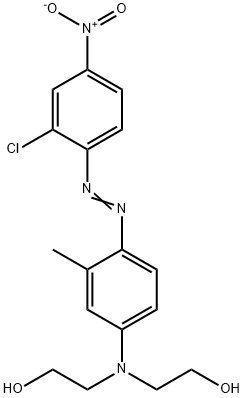DISPERSE ORANGE 3
Synonym(s):4-(4-Nitrophenylazo)aniline
- CAS NO.:730-40-5
- Empirical Formula: C12H10N4O2
- Molecular Weight: 242.23
- MDL number: MFCD00007856
- EINECS: 211-984-8
- SAFETY DATA SHEET (SDS)
- Update Date: 2025-01-27 09:38:02

What is DISPERSE ORANGE 3?
Description
Disperse orange 3 is an azo dye which can induce contact dermatitis in workers in the textile industry. Patch tests are frequently positive (about 30%) in hairdressers with a hand dermatitis. It is probably an indicator of contact sensitization to PPD, but disperse orange 3 can also be found in so me semipermanent hair dyes.
Chemical properties
red to dark brown powder
The Uses of DISPERSE ORANGE 3
Disperse orange 3 is used as a dye in acetate, nylon, silk, wool, and cotton; stocking dye.
The Uses of DISPERSE ORANGE 3
Disperse Orange 3 may be used as a test material for investigating its degradation by the white rot fungus?Pleurotus ostreatus and the products obtained upon degradation are determined using UV-visible spectrophotometric and high-performance liquid chromatographic techniques.
What are the applications of Application
Disperse Orange 3 is a dye with color index number of 11005
Definition
ChEBI: Azobenzene substituted at the phenyl 4-positions by an amino and a nitro group.
Preparation
4-Nitrobenzenamine diazo, with aniline base armour sulfonic acid coupling, and sodium hydroxide solution to boil, then a sulfonic acid hydrolysis off base.
General Description
Disperse Orange 3 (DO3) is a monoazo dye, which contains 90% dye content plus dispersing agents and surfactants. It has two aromatic rings with an amino group on one of the rings and the other is substituted with a nitro group. It shows an absorption peak majoring at 415 nm.
Contact allergens
Disperse Orange 3 is an azo dye that can induce contact dermatitis in workers in the textile industry. It is positive in a great majority of PPD-positive people, because of hydrolysis in the skin into PPD. Disperse Orange 3 can also be found in some semipermanent hair dyes.
Properties and Applications
Orange, yellow light red powder, melting point of 210-220 ℃. Soluble in ethanol, acetone, toluene, soluble fiber element. The strong sulfuric acid for green light yellow to orange diluted; Nitric acid solution for orange red; In strong hydrochloric acid for brown in the light yellow. Used for polyester and acetic acid fiber dyeing, also can be used for nylon 66 and acrylic fiber dyeing and plastic shading.
| Standard | Ironing Fastness | Light Fastness | Persperation Fastness | Washing Fastness | |||
| Fading | Stain | Fading | Stain | Fading | Stain | ||
| ISO | 4 | 2 | 5-6 | 4-5 | 5 | 4-5 | 3-4 |
Properties of DISPERSE ORANGE 3
| Melting point: | ~200 °C (dec.)(lit.) |
| Boiling point: | 385.06°C (rough estimate) |
| Density | 1.2532 (rough estimate) |
| refractive index | 1.6081 (estimate) |
| storage temp. | Refrigerator |
| solubility | Chloroform (Very Slightly, Heated, Sonicated), DMSO (Slightly), Methanol (Slight |
| Colour Index | 11005 |
| pka | 2.78±0.10(Predicted) |
| form | Powder |
| color | Red to dark brown |
| Water Solubility | 290.7ug/L(25 ºC) |
| BRN | 1842907 |
| CAS DataBase Reference | 730-40-5(CAS DataBase Reference) |
| EPA Substance Registry System | C.I. Disperse Orange 3 (730-40-5) |
Safety information for DISPERSE ORANGE 3
| Signal word | Warning |
| Pictogram(s) |
 Exclamation Mark Irritant GHS07 |
| GHS Hazard Statements |
H315:Skin corrosion/irritation H317:Sensitisation, Skin H319:Serious eye damage/eye irritation H335:Specific target organ toxicity, single exposure;Respiratory tract irritation |
| Precautionary Statement Codes |
P280:Wear protective gloves/protective clothing/eye protection/face protection. P302+P352:IF ON SKIN: wash with plenty of soap and water. P305+P351+P338:IF IN EYES: Rinse cautiously with water for several minutes. Remove contact lenses, if present and easy to do. Continuerinsing. |
Computed Descriptors for DISPERSE ORANGE 3
New Products
1-Amino-1-cyclohexanecarboxylic acid Cycloleucine 6-Bromo-3-iodo-1-methyl-1H-indazole 3-(2,4-Dimethoxybenzyl)dihydropyrimidine-2,4(1H,3H)-dione 7-Bromo-1H-indazole ELECTROLYTIC IRON POWDER 2-Methyl-2-phenylpropyl acetate 1-Aminocyclobutanecarboxylic acid 1-(2-Ethoxyethyl)-2-(piperidin-4-yl)-1H-benzo[d]imidazole hydrochloride Decanonitrile tert-butyl 4-(1H-benzo[d]iMidazol-2-yl)piperidine-1-carboxylate 4-Ethylbenzylamine Methyl 5-bromo-2-chloro-3-nitrobenzoate N-(5-Amino-2-methylphenyl)acetamide 2-Chloro-3-nitropyridine 5-Bromo-2,3-dimethoxypyridine methyl 6-chloro-2-(chloromethyl)nicotinate 2-methoxy-4-methyl-5-nitro pyridine 2-iodo-5-bromo pyridine 2-amino-4-methyl-5-nitro pyridine 5-Fluoro-2-Oxindole methyl L-alaninate hydrochloride diethyl L-glutamate hydrochloride Ethyl tosylcarbamateRelated products of tetrahydrofuran








You may like
-
 730-40-5 Disperse orange 3 98%View Details
730-40-5 Disperse orange 3 98%View Details
730-40-5 -
 Disperse orange 3 98%View Details
Disperse orange 3 98%View Details -
 Disperse Orange 3 CAS 730-40-5View Details
Disperse Orange 3 CAS 730-40-5View Details
730-40-5 -
 Disperse Orange 3 CAS 730-40-5View Details
Disperse Orange 3 CAS 730-40-5View Details
730-40-5 -
 Diethyl Disulfide 99% HPLCView Details
Diethyl Disulfide 99% HPLCView Details
110-81-6 -
 6285-05-8. 1-(4-chlorophenyl) propan-1-one 98%View Details
6285-05-8. 1-(4-chlorophenyl) propan-1-one 98%View Details
6285-05-8. -
 4-chloro-3,5-dinitropyridine 98%View Details
4-chloro-3,5-dinitropyridine 98%View Details -
 171663-13-1 tert-Butyl 3-bromobenzylcarbamate 98%View Details
171663-13-1 tert-Butyl 3-bromobenzylcarbamate 98%View Details
171663-13-1